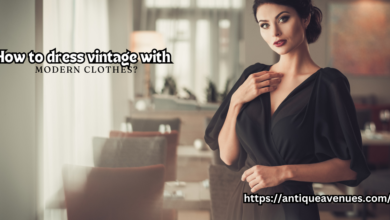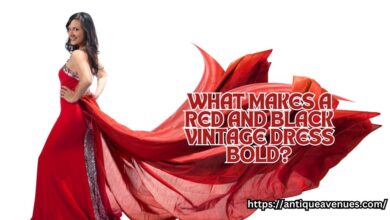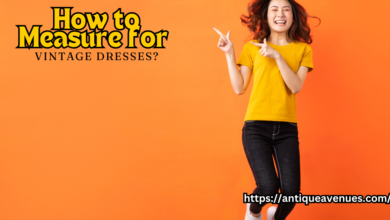What are vintage evening dress styles?

The wide range of vintage evening dress styles includes the dresses and formal gowns used at festivals during that period. These clothes are valued for their elegance, flair, and unique characteristics that encapsulate the fashion and social mores of their time. The opulent Victorian attire still influences modern fashion, the bold fashion of the 1970s, and the timeless design and advancement of older evening gowns.
Historical Evolution of Vintage Evening Dresses

The designs of vintage evening gowns have evolved greatly in terms of shape, fabric, and decorations.
Victorian Era:
The evening gowns of the clock were distinguished by their petite bodices, lengthy sleeves, and high necklines, and their flowing skirts were embellished with multiple layers of crinolines and skirts. The ribbons, lace, and stitching are usually used to draw attention to the wearer’s riches and variety, as well as luxurious substances like silk and velvet.
Edwardian Era:
The lighter, more flowing lines eased the profile created by the S-bend waistbands. The billowing skirts defined the appearance, soft colors, and delicate lace.
1920s Flapper Style:
Introducing straight, loose dresses featuring dropped waists, intricate beading, and fringe dramatically shifted the look. These dresses reflected the spirit of freedom and jazz-age glamour.
1930s–1940s:
The elegant hanging satin gowns with a bias cut gained popularity. When practical fashions with lower sleeves and simpler outlining were more popular due to wartime constraints, femininity was still valued.
1950s:
The hourglass silhouettes, with tight waists and long skirts made of tulle, satin, and taffeta, returned in the postwar era. Most especially in demand were pastels and vibrant colors.
1960s–1970s:
The following maxi dresses, mod minidresses, and elegant sheath dresses made fashion more varied. There were earth tones, bold designs, and different fabrics like jersey and chiffon.
Key Features of Vintage Evening Dress Styles

Silhouettes:
The 1920s provided straight, able patterns to gowns, but fitted bodices. The sheath, mini, and extra designs gained popularity in the 1960s and 1970s, while wide skirts and tight waists had become favorites in the 1950s.
Fabrics and Textures:
The most popular materials were taffeta, velvet, chiffon, satin, and silk. The smooth satin, soft chiffon, crisp taffeta, and occasionally lace and beaded overlays were used in dresses.
Details and Embellishments:
The embroidery, lace, beads, bows, ribbons, and rhinestones were all in style. The sweetheart, halter necks, bell sleeves, hat sleeves, and off-the-shoulder styles were among the many necklines and sleeves accessible.
Patterns and Colors:
The 1960s and 1970s saw a surge in favor of geometric patterns, polka dots, and floral design prints. The colors of watercolors were used in the 1950s, jewel-toned hues were famous in the 1960s and Victorian era, and 1970s fashion was fueled by botanical colors.
Styling and Modern Use
The right accessories typically go well with the antique evening attire, including beautiful jewelry, vintage handbags, pearl necklaces, gloves, shawls, and timeless heels. The mixing of traditional attire with current accessories can create a fresh, modern look. A person can dress these classic items to make them stand out from everyday attire and wear them to specialized events and business events.
Conclusion
The development of formal dress from the affluent Victorian era to the expressive 1970s can be seen by the styles of previous evening gowns. The fashions, fabrics, and decorations change from century to decade, vintage evening wear is a timeless solution for everyone who likes to include a little the past, flare, and individuality to their wardrobe.




One Comment